Eargo vs. Phonak
Eargo is our choice for discrete OTC hearing aids, while Phonak offers a wide range of styles for prescription hearing aids, from completely invisible to behind the ear.
SeniorLiving.org is supported by commissions from providers listed on our site. Read our Editorial Guidelines
Key Takeaways
- Eargo hearing aids can be purchased online and are designed for those with mild to moderate hearing loss who want a discreet device.
- Phonak offers prescription hearing aids purchased from hearing care professionals with options for mild to profound hearing loss.
In this article, we’ll contrast Eargo, a high-quality manufacturer of over-the-counter hearing aids, to Phonak, a technologically advanced manufacturer of prescription hearing aids. Eargo is better suited for mild to moderate hearing loss, while Phonak offers solutions for all levels of hearing loss, from mild to profound.
Our team of tech experts and audiologists have hands-on experience with both brands. In fact, Eargo and Phonak both rank on our list of the best hearing aids in 2025. In this guide, we’ll cover everything you need to know about these devices to make the best decision for you.

Eargo vs. Phonak Product Lineup

|
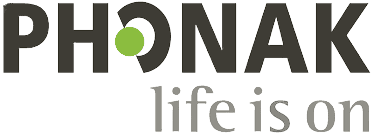
|
|
|---|---|---|
| Hearing loss levels | Mild to moderate high-frequency hearing loss | Mild to profound |
| Price range | $799 to $2,699 per pair | $3,000 to $7,500 per pair* |
| Styles offered | Completely in canal (CIC) and earbud | Behind the ear (BTE), receiver in canal (RIC), in the ear (ITE), and extended wear |
| Requires an audiogram (prescription) | No | Yes |
| How to purchase | Online | Through an audiologist |
| App connectivity | Yes | Yes |
| Battery types | Rechargeable | Rechargeable and disposable |
| Trial period length | 100 days | Varies by provider |
| (CROS) One-sided hearing loss options | No | Yes |
| Tinnitus tools | No | Yes |
| Bluetooth | Yes | Yes |
| Manufacturer’s warranty length | 1 to 2 years | Varies by provider |
| Website |
See Pricing
Links to Eargo
|
See Pricing
Links to Zip Hearing
|
*Prices listed are estimates from Dr. Ruth Reisman. Costs will vary by location and provider.
Eargo
Eargo hearing aids are for adults with mild to moderate hearing loss. If you have severe or profound hearing loss, Phonak will be a better solution for you. Unlike Phonak, Eargo doesn’t make CROS hearing aids for single-sided deafness or people who are hard of hearing in one ear only.

Several members of our team have tested Eargo’s hearing aids. One of the things we all liked was their discreet styles. If you or a loved one are holding back from wearing hearing aids because of how they look, Eargo may be a good choice for you. When we wore our Eargos, it was nearly impossible to tell we were wearing them!
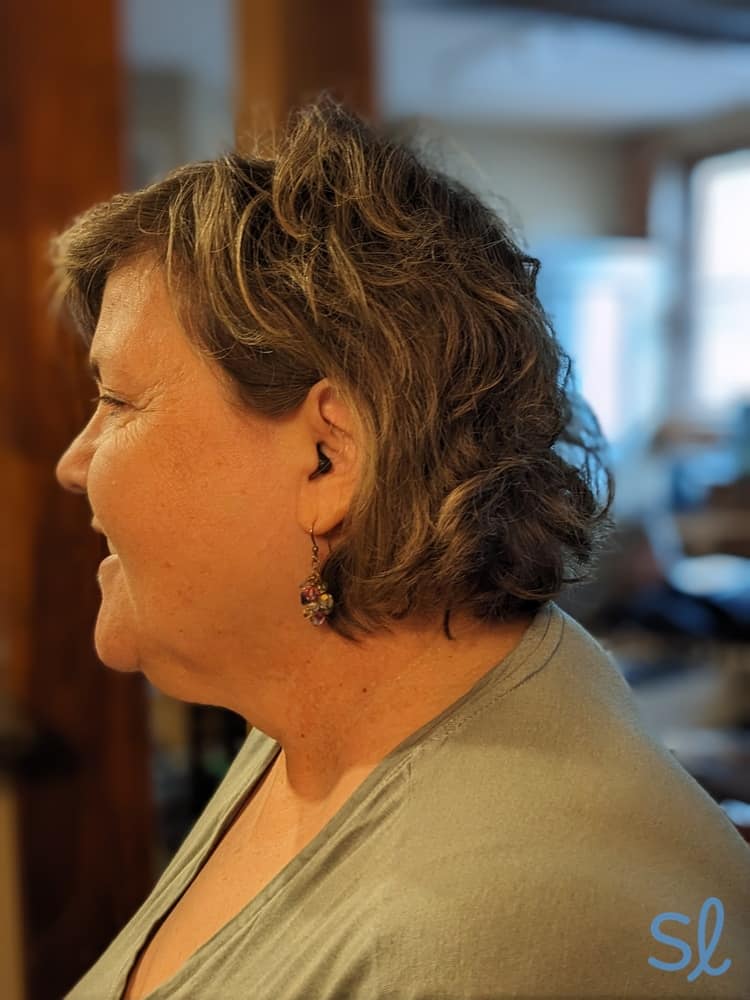
Eargo's hearing aids are nearly invisible, as seen in the photo above.
Eargo sells three completely-in-the-canal (CIC) hearing aid models and one earbud-style model. All four are rechargeable and come with small, easily transportable charging cases.
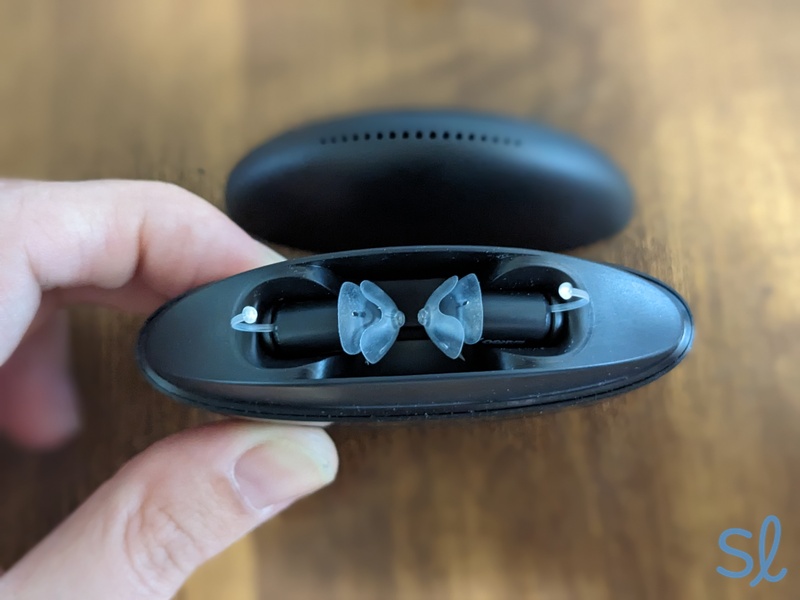
Eargo 7 in the charging case
Audiologist Dr. Brad Ingrao, a member of our panel of experts, has found Eargo’s devices are intuitive to set up and program. He also notes that their noise cancellation and feedback reduction capabilities are comparable to more expensive brands.
Eargo devices can be purchased online or in select stores. Unlike Phonak, they don’t require a prescription (audiogram) from a hearing care professional. This eliminates barriers for people who don’t want to, or can’t, get to a doctor’s office easily.
They’re also less expensive than most prescription hearing aids, including Phonak. There are less expensive OTC hearing aids, such as MDHearing and Lexie. But Eargo offers discrete designs and high-tech features that might be worth the upgrade, especially if you’re comfortable with technology and app use. Eargo 7 and Eargo SE both connect to the Eargo mobile app. We found the app to be easy to use, and it allowed us to customize our settings to improve our hearing experience. LINK by Eargo doesn’t connect to an app but has Bluetooth streaming. We listened to music and made calls using our earbud-style LINK by Eargo hearing aids, which is a nice added feature.
» Related Reading: Eargo 7 review
Eargo hearing aids come with lifetime professional support for the life of your hearing aids. You can access Eargo hearing care professionals through the app or via phone. This type of hands-on support isn’t the norm for OTC hearing aids. Just remember, you won’t have in-person support like you would with Phonak. For a closer look at our experience with Eargo’s offerings, visit our 2025 Eargo review.
Pros About Eargo
- Less expensive than prescription hearing aids
- Discreet styling
- Produces rich sound quality
- Easy to program and use
- Lifetime professional support
- Rechargeable models
Cons About Eargo
- Only for mild to moderate hearing loss
- More expensive than some OTC hearing aids
- In-person audiological care not available
Did You Know? Rechargeable hearing aids can be easier to handle than those using disposable batteries. Rechargeables may be best for people with conditions that affect hand dexterity, like arthritis and Parkinson’s disease.
Phonak
Phonak is a trusted manufacturer of technologically advanced prescription hearing aids. They can be used by people with hearing loss ranging from mild to profound. Phonak hearing aids are known for their superior sound quality in challenging environments. They’re also a popular choice for many audiologists. In fact, Dr. Ingrao fits around 75 percent of his patients with Phonak hearing aids.
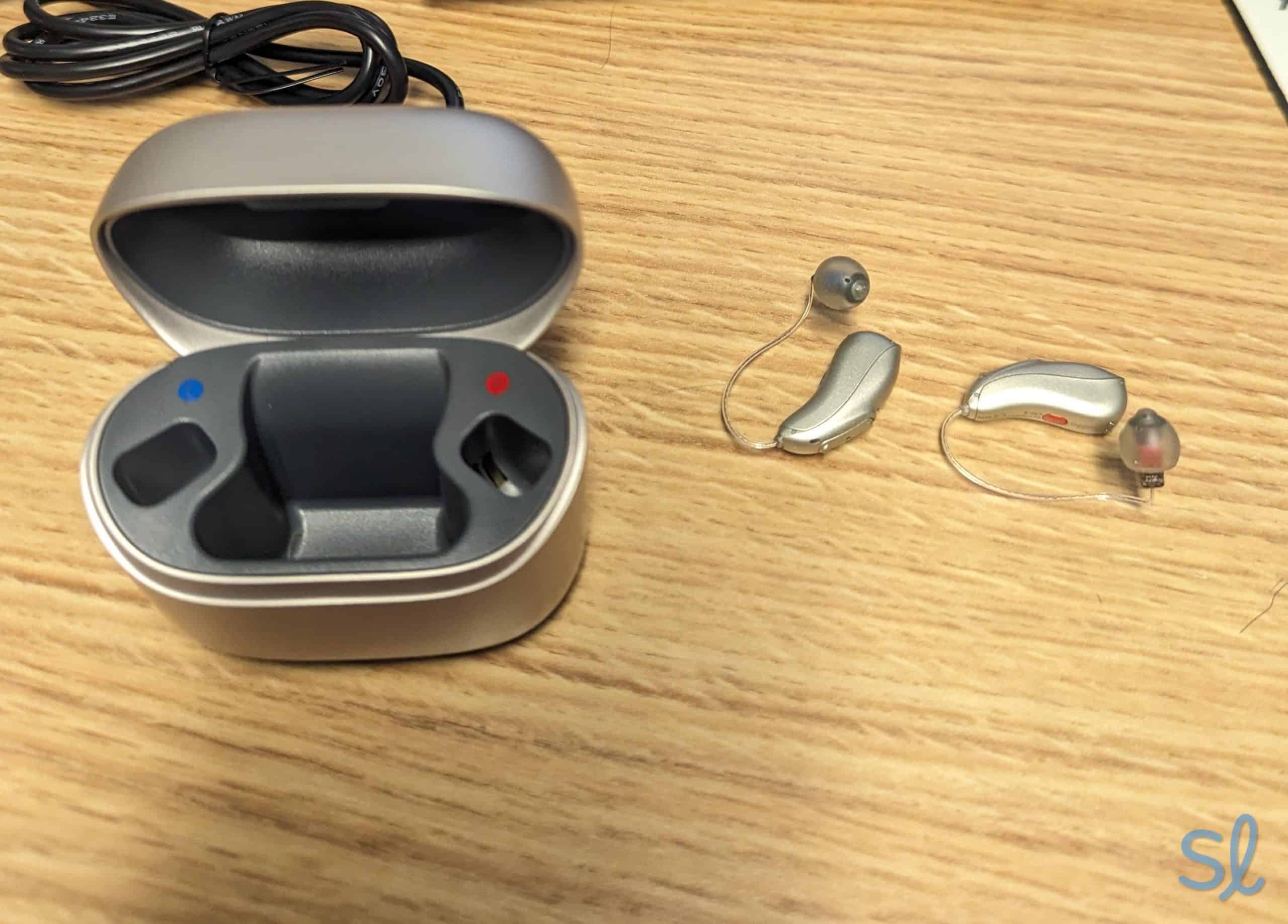
Testing out Phonak hearing aids
Phonak’s style and power options are broad. Their hearing aids include Naída Lumity, a powerful behind-the-ear (BTE) hearing aid, and Lyric, an extended wear hearing aid which remains in place within the ear for long periods. Phonak’s hearing aids utilize SmartSpeech Technology, which focuses on hearing and understanding speech with clarity and ease. We’ve found Phonak hearing aids require less straining to keep up with conversations, even in noisy environments.

Phonak’s hearing aids include rechargeable and disposable battery options, Bluetooth streaming, and app connectivity. Another plus is Phonak’s line of accessories, such as Roger Wireless microphones, remote controls, and table mics.
» Learn More: Phonak hearing aid review
Several of Phonak’s hearing aids are available on the U.S. Department of Veteran Affairs’ contract, and veterans can receive them for free or with significant discounts. These include in-the-ear (ITE) custom hearing aids and other options. We appreciate these discounts for veterans, as hearing loss and tinnitus are the most common service-connected disabilities reported by veterans and active military. Eargo offers veteran discounts of 10 to 20 percent on select devices, though they don’t offer any free options.
Some of Phonak’s hearing aids use Tinnitus Sound Therapy to reduce the brain’s perception of tinnitus (ringing in the ears). Eargo doesn’t offer any tinnitus features or sound therapy, so if you have tinnitus, that’s something to consider.
» Related Reading: Best Hearing Aids for Tinnitus in 2024
Pros About Phonak
- Extensive selection of styles and power levels
- Can be used by people with mild to profound hearing loss
- Tinnitus SoundTherapy is available
- CROS options for one-sided hearing loss or deafness
- Affordable or free options for veterans
- Wireless accessories are available
Cons About Phonak
- Can be expensive
- Requires an in-person hearing assessment
- Prices and warranties vary between providers
Eargo vs. Phonak Pricing
Eargo
Eargo hearing aids cost from $799 to $2,699 per pair. Eargo hearing aids are significantly less expensive than Phonak and other prescription hearing aid brands by a few thousand dollars. However, they offer less customization and in-depth support. The cost of Eargo hearing aids includes cleaning tools, multiple-sized eartips, and a charging case. It also includes access to hearing care support via the Eargo app or phone.
Did You Know? Untreated hearing loss increases your risk for dementia. Using hearing aids may reduce your risk, plus slow down cognitive decline.
For people who are new to hearing aids, Eargo may be an excellent choice, both for affordability and quality. They aren’t as technologically advanced as Phonak, but we’ve found Eargo’s sound quality is still excellent.
Most health insurance plans, including Medicare, don’t cover the cost of hearing aids. This puts these much-needed devices out of reach for many people. Eargo hearing aids are relatively affordable. Plus, the ability to buy them without a prescription saves you the cost of a doctor’s visit.
Phonak
Like most prescription hearing aid manufacturers, Phonak doesn’t list its pricing online. Dr. Ruth Reisman estimates Phonak hearing aids range from around $1,000 to $3,750 per ear. That translates to a cost from $2,000 to $7,500 per pair. Phonak’s prices are ultimately set by the prescriber you get them from. Geographic location and other factors may influence cost.
While the cost is high, Phonak offers a level of support you won’t receive from OTC brands like Eargo. Your hearing care professional will run several hearing screenings to ensure you choose the best hearing aid for your needs. Then, they can customize your hearing aid settings to your unique hearing loss. You’ll also have access to in-person follow-up care, which isn’t an option with Eargo.
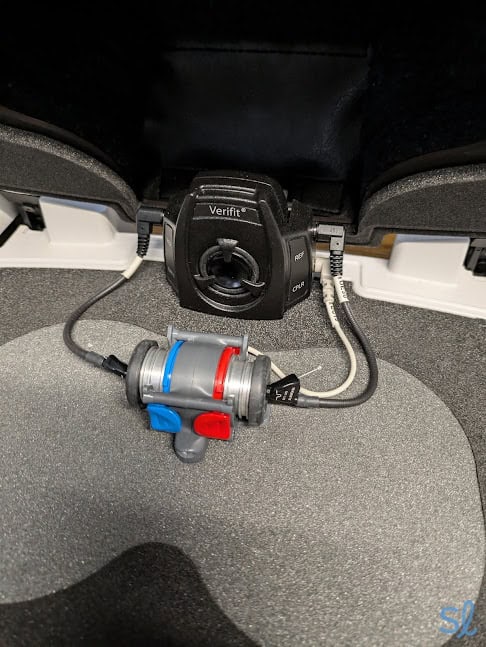
Dr. Reisman testing the sound quality of Sony s CRE-C10 hearing aids
Follow-up Support
Eargo
Our experience with Eargo’s customer and audiological support has been highly positive. Their team is professional, knowledgeable, and helpful. You can call Eargo or use the online chat feature for support on topics such as programming your devices and warranty questions. You can also reach out for programming support via the app.
When we had a question about Eargo’s petal tips and fitting our hearing aids properly, we reached out to customer support via online chat. We received a quick response, and the agent answered all of our questions.

We could easily schedule a Video Call with an Eargo Hearing Professional within the app.
Phonak
Phonak is highly reliable, and they stand behind the quality of their hearing aids. Your ongoing support, as well as your warranty and any trial period, will be determined by your provider. You can set up appointments to see your hearing specialist as needed, for help with hearing aid issues such as programming, fit, and volume control. They will also work with you on changes in your hearing level and overall hearing health. Earwax removal, ear infections, and other issues can all be handled by your provider in person.
Final Thoughts
Eargo is best for: Seniors on a budget who have mild to moderate hearing loss
Phonak is best for: Seniors who want hearing aids featuring cutting-edge technology in a variety of styles
Eargo provides cost-effective, discrete solutions for people with mild to moderate hearing loss, starting at $799 per pair. Their hearing aids can be purchased online or in stores without the need to see a hearing specialist.
Phonak produces exceptional, high-quality hearing aids for any level of hearing loss. You’ll work with a hearing specialist who will provide hands-on support and input. Phonak is more expensive than Eargo, with prices ranging from $2,000 to $7,500 per pair. For many seniors, cost may be a barrier. If so, talk to your audiologist about solutions that will work for you.

